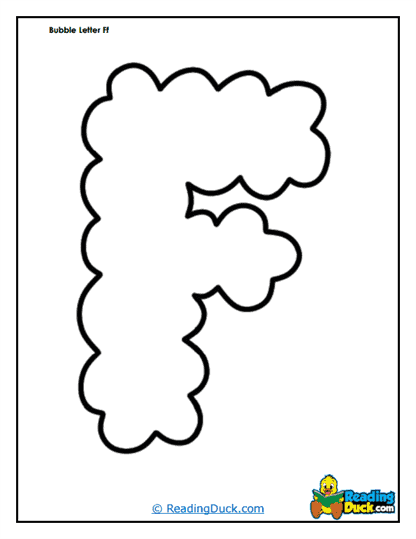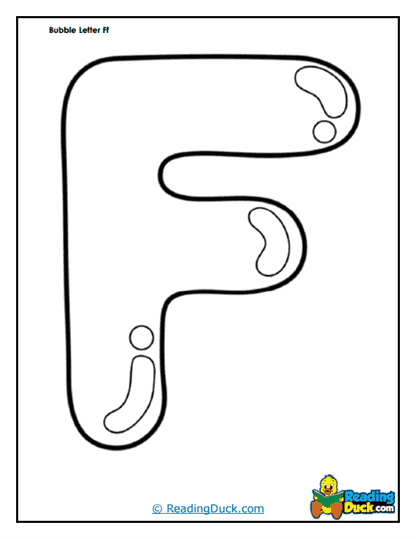Bubble Letter Ff Worksheets
About Our Bubble Letter Ff Worksheets
Bubble Letter F worksheets are creative, printable activities featuring large, bold, and stylized "F" designs. These letters are typically outlined or themed in a way that makes them visually appealing and interactive. The worksheets are designed to inspire creativity, strengthen foundational skills, and support various educational goals, from letter recognition to fine motor development.
These resources often serve as a gateway to learning for children, especially those in early elementary grades. The oversized, playful design of the bubble letters captures students' attention, making learning an enjoyable experience. Bubble Letter F worksheets are not just about writing a letter—they open the door to exploration, creativity, and hands-on learning.
Why Are They Valuable?
1. Support Language Arts Foundations
They play a critical role in building early literacy skills, as they help children recognize and master the letter "F." Learning the alphabet is the foundation of reading and writing, and these worksheets make the process more accessible and enjoyable for young learners. By focusing on just one letter at a time, students can deeply understand its unique shape, phonetic sound, and position within words. This focused approach reduces overwhelm and encourages better retention of the information. Additionally, activities like identifying words that start with "F" or tracing the letter promote meaningful connections between the written form of the letter and its practical uses in language.
2. Foster Fine Motor Development
The intricate designs of these worksheets encourage children to engage in activities that improve precision and hand control. Tracing and coloring the large, rounded shapes of the letter help strengthen the small muscles in their fingers and hands, which are crucial for writing skills. These fine motor skills are also essential for other tasks, such as cutting, tying shoes, and using utensils. Furthermore, these worksheets offer repetitive practice, allowing children to refine their grip and improve their hand-eye coordination over time. As a result, they provide an excellent platform for developing the foundational skills needed for more advanced handwriting and drawing activities in the future.
3. Encourage Creativity
They provide a fantastic opportunity to spark creativity in young learners. Coloring and decorating the letter allows children to express themselves artistically, choosing colors and designs that reflect their personalities and preferences. For example, they might use their favorite shades to fill in the letter, add intricate patterns like stripes or polka dots, or even incorporate additional elements such as flowers, stars, or feathers. By allowing personalization, these worksheets turn a simple activity into an enjoyable creative outlet. Moreover, this creative engagement helps children view learning as a fun and positive experience, encouraging them to explore new ideas and approaches in other educational activities.
4. Flexible for Various Learning Settings
They also are incredibly versatile and can be adapted to suit a variety of learning environments. In classrooms, they can be integrated into lesson plans as part of literacy or art instruction, fostering collaboration and discussion among students. For homeschooling families, they offer a structured yet engaging way to reinforce the alphabet in a one-on-one setting. At home, parents can use these worksheets as a quiet-time activity or a supplement to their child's existing learning routines. Additionally, educators and parents can tailor the worksheets to specific themes or occasions, such as decorating the "F" for fall, festivals, or family-related activities, making the experience more relevant and exciting for the child. This adaptability ensures that the worksheets remain a valuable resource for supporting a wide range of educational goals.
Styles and Varieties
This series comes in many styles, each with its own unique educational and creative purpose. These worksheets are designed to make learning the letter "F" an engaging and multifaceted experience for children. By using different approaches, they cater to various learning styles and developmental goals, fostering not only letter recognition but also creativity and critical thinking. Let’s explore some of the common varieties you’ll find:
Outline-Only Bubble Letters
These feature large "F" designs with just the outline, leaving the interior blank. This blank space provides children with the freedom to color or decorate the letter in any way they wish, sparking their imagination and encouraging personal artistic expression. This format also serves as an excellent tracing activity, allowing young learners to practice the formation of the letter "F" while improving their hand-eye coordination. Additionally, these worksheets are ideal for introducing foundational writing skills in a relaxed and enjoyable way, making the learning process feel more like play than work.
Shaded or Filled
They take the concept a step further by incorporating intricate patterns or designs inside the letter "F." These could include themes like floral arrangements, polka dots, stripes, or even abstract geometric shapes. By focusing on coloring within these pre-designed areas, students are challenged to practice precision, fine motor skills, and attention to detail. Furthermore, the variety of patterns keeps children engaged and entertained, while subtly enhancing their artistic abilities. This type of worksheet also introduces an additional layer of complexity, making it a suitable choice for older children or those who enjoy a more detailed artistic challenge.
Themed
Themed sheets are a delightful way to integrate learning with real-world concepts and seasonal or cultural elements. For instance, an "F" might be designed to resemble a fish or decorated with imagery like flowers in spring or snowflakes in winter. These themed designs make the worksheet more relatable and memorable by tying the letter to familiar objects or events. As a result, children are better able to understand the relevance of the letter in everyday life and retain their learning more effectively. Additionally, themed worksheets can add an element of fun to learning, especially when tied to holidays or special occasions, keeping children excited and motivated.
The Educational Benefits
1. Language Arts Skills
Bubble Letter F worksheets serve as an interactive and engaging way to teach the alphabet, providing a multisensory approach to language arts learning. By working with these worksheets, students actively improve their letter recognition skills, identifying the letter "F" within various contexts and among other letters. This skill helps them to distinguish specific shapes and forms that make up the letter "F," reinforcing their understanding of how letters function within written language. Phonemic awareness is another critical aspect of these worksheets, as students learn to associate the visual representation of the letter "F" with its corresponding sound. Activities such as saying the sound aloud while tracing the letter reinforce auditory and kinesthetic learning. Additionally, students are encouraged to develop word connections by brainstorming and listing words that begin with the letter "F," such as "fish," "frog," and "feather." This activity expands their vocabulary and highlights how the letter contributes to word formation. Furthermore, these worksheets can integrate activities like forming simple sentences or identifying the letter "F" in existing texts, adding depth to their literacy development.
2. Fine Motor Skills
These sheets play a significant role in developing fine motor skills, as they require precise hand movements and coordination. Activities such as tracing, coloring, or decorating bubble letters involve the use of small muscles in the hands and fingers, which are essential for tasks like writing and drawing. Repeated tracing of the letter "F" strengthens these muscles, improving the child’s ability to control writing tools over time. Coloring within the lines of the bubble letters also enhances hand-eye coordination, teaching students to synchronize their hand movements with their visual input. These exercises are fundamental for building foundational skills for writing neatly and legibly. Another essential benefit is the development of a proper pencil grip; by manipulating writing or coloring tools, students practice holding pencils or crayons in a way that supports better control and reduces fatigue. Through these activities, children not only develop motor skills but also gain confidence in their ability to perform tasks requiring precision and focus. Additionally, bubble letter worksheets introduce a playful and engaging way to practice these skills, encouraging perseverance and attention to detail.
3. Creative Expression
They provide a unique opportunity for students to explore their creativity, which is an essential aspect of personal growth and innovation. The large, blank spaces within the bubble letters allow children to experiment with different color combinations, giving them a chance to make artistic choices that reflect their individual preferences. This open-ended activity encourages students to express themselves without fear of making mistakes, as there is no single correct way to decorate the letters. They can also experiment with patterns and textures, such as adding stripes, polka dots, or other designs, to make their letters visually interesting and dynamic. These exercises promote thinking outside the box and foster a sense of originality. Additionally, students can incorporate unique artistic elements, such as glitter, stickers, or collaged materials, to personalize their creations further. This type of artistic play not only enhances their engagement but also builds confidence in their ability to create something unique. Beyond the artistic value, such creative activities also develop problem-solving skills, as students decide how best to bring their ideas to life within the constraints of the worksheet.
4. Social and Emotional Learning
They are also great for promoting social and emotional learning by encouraging collaboration and communication. In a classroom setting, these worksheets can become a shared activity, as students compare their decorated letters or work together on group projects. This fosters teamwork, teaching students how to cooperate, share ideas, and respect the creativity of their peers. For example, students might collaborate to create a word wall or a class poster featuring their decorated "F" letters, which encourages them to contribute to a collective goal. Additionally, sharing their work provides opportunities to build social skills, such as giving and receiving constructive feedback or celebrating each other’s efforts. These activities also help students develop a sense of empathy and appreciation for diversity, as they recognize and value the unique styles and approaches of their classmates. On an emotional level, working on creative tasks in a supportive environment helps students build confidence in their abilities, reducing anxiety and fostering a positive attitude toward learning. By combining artistic expression with social interaction, these worksheets contribute to a holistic educational experience.









